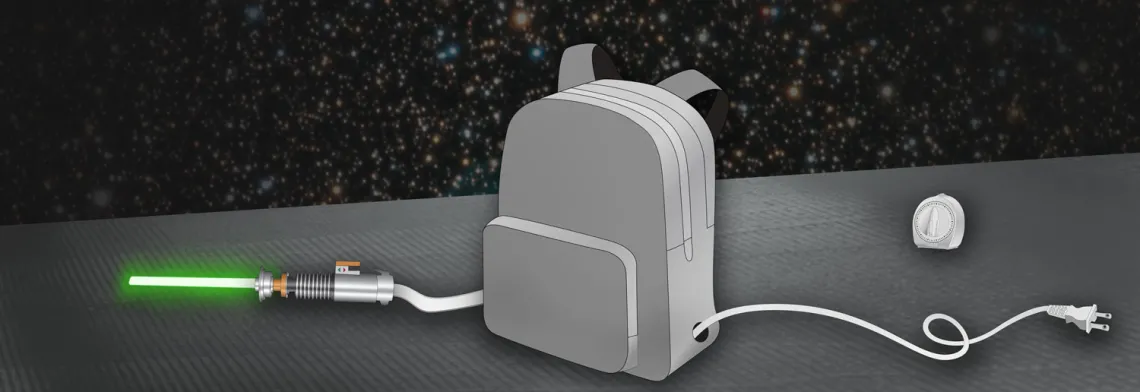The Lightsaber's Energy Crisis
UA Optical scientist Jason Jones explores the reasons why we don't have real-life lightsabers.

Darth Vader stands opposite Luke Skywalker. His red lightsaber is tethered to an oversized backpack with a battery and an extension cord inside. He marches slowly towards Luke, the back of his helmet getting momentarily caught up in the zipper of his pack. As Darth Vader plunges the laser sword towards his adversary’s blue lightsaber, it moves clear through the light. It makes no sound. There’s no resistance. After a few minutes of this nonsensical jousting, the lightsaber, depleted of battery life, goes dark. Darth Vader asks Luke Skywalker for a moment to find an electrical outlet. After scouring the walls of Cloud City and finding a suitable place to plug in, he’s back in action. But since the photons of light emitting from his lightsaber don’t do very much—or anything, really—to interact with the photons from his enemy’s lightsaber, he instead pins Skywalker down on the floor and painstakingly cuts off his hand with the laser, making certain not to stray too far from the outlet that’s keeping it running.
According to Jason Jones, that’s what a lightsaber battle scene would look like in real life: terminally dopey.
Jones, an associate professor in the University of Arizona’s College of Optical Sciences and head of the Jones Research Group, knows a thing or two about lasers. And although he’s a “Star Wars” fan who received a toy lightsaber for his birthday, he says laser swords are easier said than done for a couple reasons, battery power and light physics chief among them.
Curiously, although they emit light, the lightsabers in “Star Wars” aren’t made of it. They are said to be made of plasma—a hot, gassy blend of ions—wrapped in a “force containment field,” which is probably some kind of electromagnetic field, says Jones. He adds that the lightsaber might be better off if it were made of, well, light.
Light is made of photons, which “don’t like to interact with each other,” so sword-fighting with light would be futile. The physics just aren’t there. But, say, cutting off a hand with it? Tricky, but not impossible: “There are many different ways in which light interacts with matter. One common way is the light energy is simply absorbed and converted into heat, which is how lasers are often used for cutting things,” says Jones. Also, while both light and plasma can be used to cut and burn things, only light is weightless, yet it has momentum. Light can push and even pull objects toward it.
Laser weapons are already used for military defense today. In that sense, it’s not so hard to imagine a laser sword.
But the lightsaber can’t exist in real life today. Fundamentally, it presents a power problem.
“That’s really the killer, I think. Whether you’re using plasma or light, the energy requirements for any of these lightsabers are going to be huge. Like in a lot of cool, important technological areas, batteries are the bottleneck. Even if you could get batteries with the necessary energy density, you’d need to recharge them very quickly and that’s not going to work in the middle of a battle,” says Jones.
But for Jones, “Star Wars” is a family affair, kept (mostly) separate from his work. He looks forward to seeing the latest film, “Star Wars: The Force Awakens,” in theaters this month.
“My wife pointed out to me that everything I’m saying is ridiculous because I don’t know the laws of physics on Tatooine. So, I have to qualify: This only applies on Earth. And maybe it’ll be different when my daughter’s old enough to ask me questions about ‘Star Wars’ and I have to decide whether or not to rain on her parade, but, for now, I like it because it’s nostalgic.”

